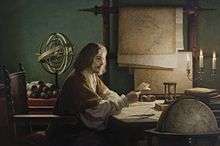Diogo Ribeiro


Diogo Ribeiro, also known as Diego Ribero, was a Portuguese cartographer and explorer who worked most of his life in Spain. He worked on the official maps of the Padrón Real (or Padrón General ) from 1518-1532. He also made navigation instruments, including astrolabes and quadrants.[1]
Early life
Born as Diogo Ribeiro, he was the son of Afonso Ribeiro and Beatriz de Oliveira.[1] However, there is no known record of the date and place of his birth. He is believed to have become a seaman at an early age and made several voyages to India as a ship pilot. Reportedly, Ribeiro sailed with Pedro Afonso de Aguiar who served as captain in the Armadas of the explorers Vasco da Gama (1502), Lopo Soares (1504), and Afonso de Albuquerque (1509).[1]
.jpeg)
Career
By 1516 Diogo Ribeiro and other several Portuguese navigators and cartographers, conflicting with King Manuel I of Portugal, gathered in Seville to serve the newly crowned Charles V. Among them were explorers and cartographers Diogo and Duarte Barbosa, Estêvão Gomes, João Serrão, Ferdinand Magellan and Jorge Reinel, cosmographers Francisco and Ruy Faleiro and the Flemish merchant Christopher de Haro. Ribeiro started working for Charles I (and V of the Holy Roman Empire) in 1518, as a cartographer at the Casa de Contratación in Seville.[2] Ferdinand Magellan took part in the development of the maps used in the first circumnavigation of the Earth.
On January 10, 1523, he was named Royal Cosmographer and "master in the art of creating maps, astrolabes, and other instruments". He eventually succeeded Sebastian Cabot (who left on a voyage) as the head cartographer. Cabot published his first map in 1544.
In 1524, Ribeiro participated in the Castilian (Spanish) delegation at the Conference of Badajoz, where Castile (Spain) and Portugal discussed whether the Philippines were on the Castilian or Portuguese side of the Treaty of Tordesillas.
In 1527, Ribeiro finished the Padrón Real, the official (and secret) Spanish map used as template for the maps present in all Spanish ships. It is considered the first scientific world map.
In 1531, he invented a bronze water pump that was able to pump water out ten times faster than the previous models.
Diogo Ribeiro died in 1533.
First scientific world map
Ribeiro's most important work is the 1527 Padrón Real. There are 6 copies attributed to Ribeiro,[3] including at the Weimar Grand Ducal Library (1527 Mundus Novus) and at the Vatican Library, in Vatican City (1529 Propaganda Map or Carta Universal).[3] The layout of the map (Mapamundi) is strongly influenced by the information obtained during the Magellan-Elcano trip around the world.
Diogo's map delineates very precisely the coasts of Central and South America. It shows the whole east coast of the Americas but of the west coast only the area from Guatemala to Ecuador. However, neither Australia nor Antarctica appear, and the Indian subcontinent appears too small. The map shows, for the first time, the real extension of the Pacific Ocean. It also shows, for the first time, the North American coast as a continuous one (probably influenced by Estêvão Gomes's exploration in 1524/25). It also shows the demarcation of the Treaty of Tordesillas. The absence of any large continent south of Asia is evidence that there had been no discovery of Australia at that date.
Notes
[n] - Diego Ribero's name also appears as "Diogo Ribeiro" in Portuguese documents.[2][3]
[r] - An exhibit of Padron Real was March 2002, in "Florida, the Making of a State".[4]
[s] - The main sources include:
[1][5][2][3][6][7]
- 1 2 3 4 "The Cartographer Diogo Ribeiro", L. A. Vigneras, 1962, Imago Mundi, Ltd., Jstor webpage: Jstor-304.
- 1 2 3 "Marvellous countries and lands" (Notable Maps of Florida, 1507-1846), Ralph E. Ehrenberg, 2002, webpage: BLib3: notes some head mapmakers.[r]
- 1 2 3 4 "Carta Universal" (slide description, Ribero bio), Henry-Davis.com, webpage: HDav346.
- ↑ "Introduction" (for exhibit "Florida, the Making of a State"), Broward County Libraries, Florida, March 2002, webpage: BL2.
- ↑ "Science in the Spanish and Portuguese Empires, 1500–1800", Daniela Bleichmar, Paula De Vos et al., USC, 2008, web (PDF): UBP.
- ↑ "The story of maps", Lloyd Arnold Brown, 1979, page 143, Google Books webpage: BG-7BkC: notes 1527 Padron General, old Alcazar.
- ↑ "Cabot Explorations in North America", D.O. True, 1956, Jstor, webpage: Jstor-236: notes General "after August 2, 1527".
| Wikimedia Commons has media related to Maps by Diego Ribero. |
External links
- (in Spanish) "Las cartas universales de Diego Ribero (siglo XVI)", by Cesáreo Fernández Duro
- "Los descubrimientos geográficos de los siglos XVI y XVII abrieron la era de la cartografía: La nueva cara del orbe", in Revista Ministerio de Fomento, July-August 2005
- Description of Carta Universal by Diego Ribero, Henry-Davis.com.
